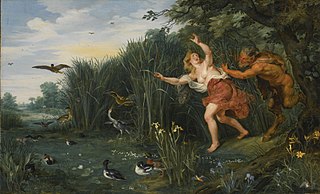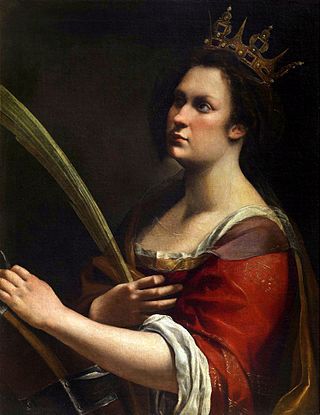
Abraham Willemsens or Abraham Willemsen [1] (c. 1605-1610 - 1672), was a Flemish painter of history and genre paintings. [2] His genre scenes were reminiscent of the style of the Le Nain brothers. He also produced copies after the works of Rubens.

Abraham Willemsens or Abraham Willemsen [1] (c. 1605-1610 - 1672), was a Flemish painter of history and genre paintings. [2] His genre scenes were reminiscent of the style of the Le Nain brothers. He also produced copies after the works of Rubens.
Details about his early life such as his birth date and place are unknown. In 1627-1628 he is recorded in the Antwerp Guild of Saint Luke as a pupil of Gilliam Antonissens (also called Guillaume Anthoni), a French painter active in Antwerp. Willemsens married Maria de Lang. In 1645, he was elected dean of the Guild. He was recorded in Paris the same year. [3]

It is assumed that he operated a big workshop with a large output to supply the export market. As a result, a large number of his paintings can be found in Spain. He was recorded in the archives of the prominent Antwerp art dealer Guillam Forchondt in 1669 and also worked for the art dealer Matthijs Musson. [4] He was active as an art dealer himself. He had two apprentices, respectively in the years 1651/52 and in 1654/55. [5]
He died in Antwerp.
The painter was virtually unknown until the discovery in the early 1990s of a painting bearing his full signature. Since then his oeuvre has gradually been reconstituted. Numerous attribution issues had to be dealt with as Willemsens was not the only contemporary painter who used the monogram AW. The artists Artus Wolffort and Adriaen Willemhoudt also signed with the monogram AW. The monogrammist AW who was responsible for a number of oil on copper paintings held by the Prado Museum has now been conclusively identified as Adriaen Willemhoudt. Because of the similarity in style there have also been misattributions of Willemsens' work to Willem van Herp.

Willemsens has further been identified with the anonymous master previously referred to as the Master of the Béguins. This notname was given to this anonymous master active in Paris in the mid 17th century because he often depicted beguines. The style of this master's works were grouped because of their subject matter and their closeness in style to that of the Le Nain brothers.. [5] The identification of Willemsens with the Master of the Béguins has not been unanimously accepted in the art historical community. [6]
Willemsens is recorded in Paris around 1645 and this can explain the influence of the Le Nain brothers who were active in Paris at that time where they painted peasant scenes. [5] Aside from the subject matter, another reason why Willemsens' work has often been misattributed to the Le Nains is that, like the Le Nains, he habitually used coarse linen as the canvas support. [4]
In response to the contemporary demand for copies of Rubens' oil sketches, Willemsens produced a large number of copies of Rubens' work. Willemsens was together with Pieter van Lint and Willem van Herp one of the principal producers of such copies for the Antwerp art dealers. [3] In addition to copies after Rubens, Willemsens painted landscapes on copper, often animated with religious or genre scenes. His figures were derived primarily from paintings by Rubens, Hendrick van Balen and Gerard Seghers. Willemsens also took inspiration from Jan Brueghel the Elder, Frans Francken the Elder and the Le Nain brothers. [4]

Baroque painting is the painting associated with the Baroque cultural movement. The movement is often identified with Absolutism, the Counter Reformation and Catholic Revival, but the existence of important Baroque art and architecture in non-absolutist and Protestant states throughout Western Europe underscores its widespread popularity.

Jan Brueghelthe Younger was a Flemish Baroque painter. He was the son of Jan Brueghel the Elder, and grandson of Pieter Bruegel the Elder, both prominent painters who contributed respectively to the development of Renaissance and Baroque painting in the Habsburg Netherlands. Taking over his father's workshop at an early age, he largely painted the same subjects as his father in a style which was similar to that of his father. He gradually was able to break away from his father's style by developing a broader, more painterly, and less structured manner of painting. He regularly collaborated with leading Flemish painters of his time.

In art history, "Old Master" refers to any painter of skill who worked in Europe before about 1800, or a painting by such an artist. An "old master print" is an original print made by an artist in the same period. The term "old master drawing" is used in the same way.

The Caravaggisti were stylistic followers of the late 16th-century Italian Baroque painter Caravaggio. His influence on the new Baroque style that eventually emerged from Mannerism was profound. Caravaggio never established a workshop as most other painters did, and thus had no school to spread his techniques. Nor did he ever set out his underlying philosophical approach to art, the psychological realism which can only be deduced from his surviving work. But it can be seen directly or indirectly in the work of Rubens, Jusepe de Ribera, Bernini, and Rembrandt. Famous while he lived, Caravaggio himself was forgotten almost immediately after his death. Many of his paintings were re-ascribed to his followers, such as The Taking of Christ, which was attributed to the Dutch painter Gerrit van Honthorst until 1990.

David Teniers the Younger or David Teniers II was a Flemish Baroque painter, printmaker, draughtsman, miniaturist painter, staffage painter, copyist and art curator. He was an extremely versatile artist known for his prolific output. He was an innovator in a wide range of genres such as history painting, genre painting, landscape painting, portrait and still life. He is now best remembered as the leading Flemish genre painter of his day. Teniers is particularly known for developing the peasant genre, the tavern scene, pictures of collections and scenes with alchemists and physicians.

Abraham van Diepenbeeck was Dutch painter, draftsman, glass painter, print maker and tapestry designer who worked most of his active career in Antwerp. He designed glass windows for various churches and monasteries in Antwerp for which he made many design drawings and oil sketches. He engraved and designed many prints which were published by prominent Antwerp printers such as van Meurs, the Plantin Press and Martinus van den Enden the Elder. He had a close relationship with the workshop of the leading Flemish Baroque painter Peter Paul Rubens and collaborated on various projects under the direction of Rubens. In the 1630s van Diepenbeeck started to create monumental paintings. His work was influenced by Rubens and Anthony van Dyck.

Cornelis de Vos was a Flemish painter, draughtsman and art dealer. He was one of the leading portrait painters in Antwerp and is best known for his sensitive portraits, in particular of children and families. He was also successful in other genres including history, religious and genre painting. He was a regular collaborator with Rubens.

Theodoor Rombouts was a Flemish painter who is mainly known for his Caravaggesque genre scenes depicting lively dramatic gatherings as well as religiously-themed works. He is considered to be the primary and most original representative of Flemish Caravaggism. These Caravaggisti were part of an international movement of European artists who interpreted the work of Caravaggio and the followers of Caravaggio in a personal manner.

Adriaen van Nieulandt was a Dutch painter, draughtsman and engraver of Flemish descent. He is known for his history paintings with biblical and mythological subjects, often incorporating elegant nudes, portraits including schutterstukken, genre paintings and still lifes.

Pieter van Lint or Peter van Lint (1609–1690) was a Flemish painter, draughtsman and designer of tapestries. He excelled in history paintings, genre scenes and portraits in the Flemish Baroque style with some Classisizing influence. He worked in Antwerp and Italy.

Simon de Vos was a Flemish painter, draughtsman and art collector. He started his career making small-format cabinet pictures of genre scenes, in particular of Caravaggesque merry companies. Later he switched to history painting, working on larger formats in a Flemish Baroque style which was influenced by Rubens and van Dyck.

Flemish Baroque painting was a style of painting in the Southern Netherlands during Spanish control in the 16th and 17th centuries. The period roughly begins when the Dutch Republic was split from the Habsburg Spain regions to the south with the Spanish recapturing of Antwerp in 1585 and goes until about 1700, when Spanish Habsburg authority ended with the death of King Charles II. Antwerp, home to the prominent artists Peter Paul Rubens, Anthony van Dyck, and Jacob Jordaens, was the artistic nexus, while other notable cities include Brussels and Ghent.

Jan Cossiers was a Flemish painter and draughtsman. Cossiers' earliest works were Caravaggesque genre works depicting low life scenes. Later in his career he painted mostly history and religious subjects as well as portraits. Cossiers was one of the leading painters in Antwerp after Rubens' death in 1640 and one of the most original colorists in 17th-century Flanders. He was an accomplished draughtsman who created some sensitive portrait drawings executed in a very varied and fluid manner.

Willem van Herp (I) or Willem van Herp the Elder (variations on first name: 'Guilliam', 'Gilliam' and 'Guillaume') (c. 1614 in Antwerp – 1677) was a Flemish Baroque painter specializing in religious paintings and small cabinet paintings of "low-life" genre scenes. He operated a large workshop and through his good connections with Antwerp art dealers helped spread the Flemish Baroque style internationally.
Matthijs Musson was a painter and art dealer based in Antwerp, who played an important role in popularizing artists of the 17th-century Antwerp school by marketing them throughout Europe.

Adriaen or Adriaan van Stalbemt or Adriaen van Stalbempt was a Flemish painter and printmaker who is known for his landscapes with religious, mythological and allegorical scenes. He was also a gifted figure painter who was regularly invited to paint the staffage in compositions of fellow painters.

Anton Goubau or Anton Goebouw was a Flemish Baroque painter. He spent time in Rome where he moved in the circle of the Bamboccianti, a name given to mainly Dutch and Flemish genre painters who created small cabinet paintings of the everyday life of the lower classes in Rome and its countryside. He is known for his Italianate landscapes and genre paintings in the style of the Bamboccianti and his history paintings with mythological and religious themes.

Paulus Pontius was a Flemish engraver and painter. He was one of the leading engravers connected with the workshop of Peter Paul Rubens. After Rubens' death, Pontus worked with other leading Antwerp painters such as Anthony van Dyck and Jacob Jordaens.

Willem Forchondt, or Guillam Forchondt the Elder (1608–1678) was a Flemish painter, cabinet maker and art dealer. He operated a successful painting workshop and a profitable dealership which extended throughout Europe through the satellite offices operated by his sons in Vienna, Lisbon and Cadiz. His international art dealership played an important role in the spread of Flemish Baroque art in Europe and South-America. He changed the relationship between art dealer and artist by becoming involved in the organisation of the art production process.

Pieter van Overschie or Pieter van Overschee was a Flemish still life painter who was active in Antwerp between 1640 and 1672. He is known for his fruit still lifes and game still lifes.
